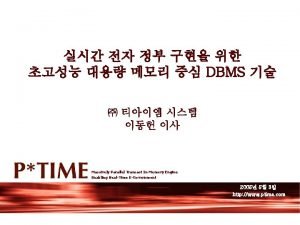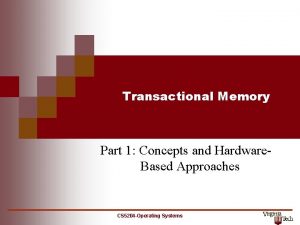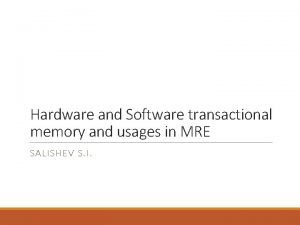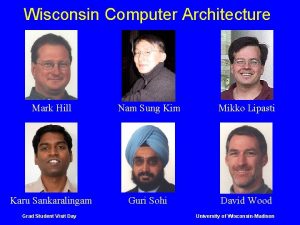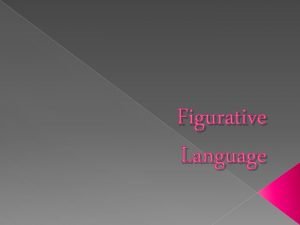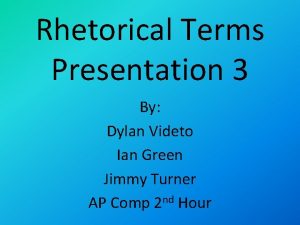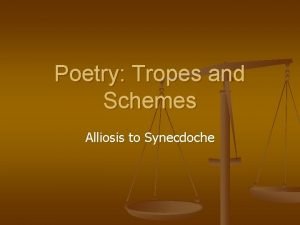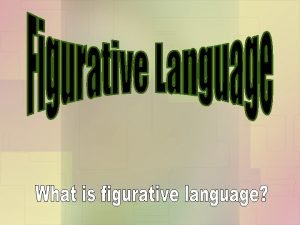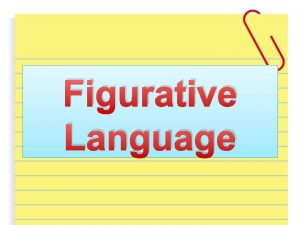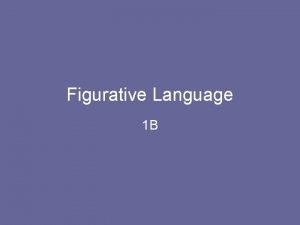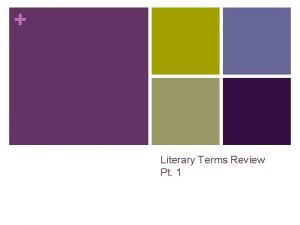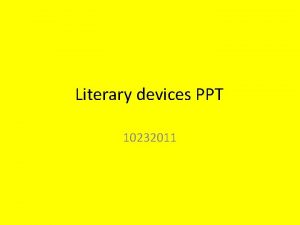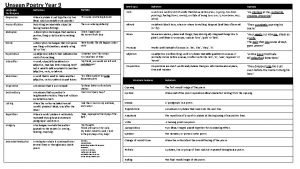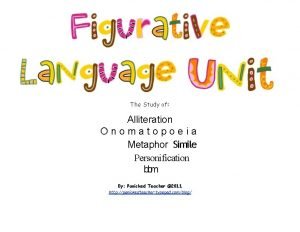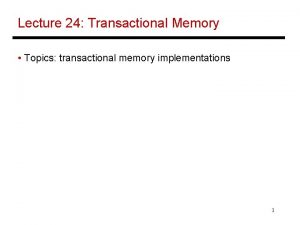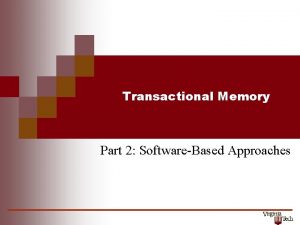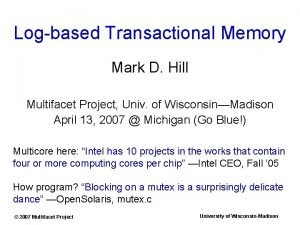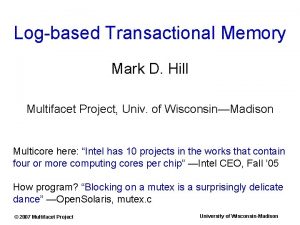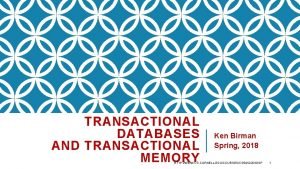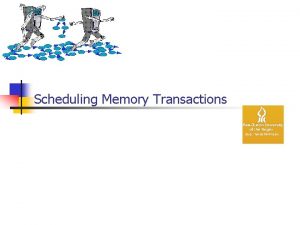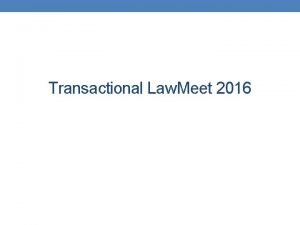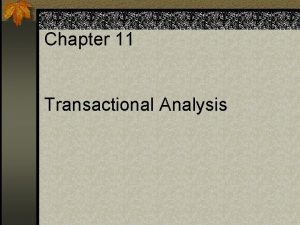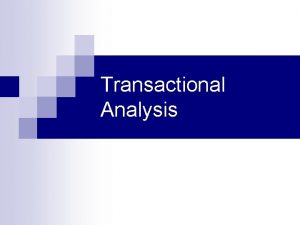Is Transactional Memory an Oxymoron Mark D Hill














































![Lock Manager [Gray/Reuter ~Fig. 8. 8] Transaction Table Lock Hash Table 1 st Lock Lock Manager [Gray/Reuter ~Fig. 8. 8] Transaction Table Lock Hash Table 1 st Lock](https://slidetodoc.com/presentation_image/299e127b93eea8a80d022f05611ee339/image-47.jpg)

![Latch Transactional Lock Elision (TLE) Ack: Mark Moir, TLE [Dice et al. Transact 08] Latch Transactional Lock Elision (TLE) Ack: Mark Moir, TLE [Dice et al. Transact 08]](https://slidetodoc.com/presentation_image/299e127b93eea8a80d022f05611ee339/image-49.jpg)











![Futile. Stall Dueling. Upgrades Friendly. Fire HTM Performance Pathologies [ISCA 2007 & Top Picks] Futile. Stall Dueling. Upgrades Friendly. Fire HTM Performance Pathologies [ISCA 2007 & Top Picks]](https://slidetodoc.com/presentation_image/299e127b93eea8a80d022f05611ee339/image-61.jpg)



- Slides: 64

Is Transactional Memory an Oxymoron? Mark D. Hill Computer Sciences Department University of Wisconsin—Madison http: //www. cs. wisc. edu/~markhill August 2008 @ VLDB in Auckland, NZ Aren’t transactions about durability? Memory is not durable! © 2008 Multifacet Project University of Wisconsin-Madison

My Connection to VLDB De. Witt Ailamaki Hill VLDB 1999: Ailamaki, De. Witt, Hill, & Wood, VLDB 1999 DBMSs on a Modern Processor: Where Does Time Go? VLDB 2001 Best Paper: Ailamaki, De. Witt, Hill, & Skounakis Weaving Relations for Cache Performance 9/15/2020 2 TM @ VLDB'08

Why this Keynote? 1. Multicore chips here & cores multiplying fast 4 cores now AMD Quad Core 16 cores 2009 Sun Rock 80 cores in 20? ? Intel Tera. FLOP 2. Hardware Transactional Memory soon 3. Is Transactional Memory relevant to DB community? 9/15/2020 3 TM @ VLDB'08

Teaching Goals of this Keynote 1. Introduce Transactional Memory (TM) – Programmers specifies instruction sequences as atomic – Motivated & facilitated by emerging multicore HW 2. Show TM Transactions != DBMS Transactions – Different Purpose, State, & Implementation 3. Explore Impact to DB-like Applications – E. g. , Transactional Latch Elision Bottom Line: Multicore HW impacts SW; TM may help 9/15/2020 4 TM @ VLDB'08

Outline • Multicore & Implications – Moore’s Law(s), Multicore HW, & SW Implications • Transactional Memory • Best-Effort Hardware Transactional Memory • Best-Effort HTM Example • Impact to DB-like Applications • Unbounded Hardware Transactional Memory 9/15/2020 5 TM @ VLDB'08

Technology & Moore’s Law Transistor 1947 Integrated Circuit 1958 (a. k. a. Chip) Moore’s Law 1964: # Transistors per Chip doubles every two years (or 18 months) 9/15/2020 6 TM @ VLDB'08

Architects & Another Moore’s Law 2300 transistors 1971 50 M transistors ~2000 Popular Moore’s Law: Processor (core) performance doubles every two years 9/15/2020 7 TM @ VLDB'08

Multicore Chip (a. k. a. Chip Multiprocesors) Why Multicore? L 4 4 L 2 2 $ $ d d a a t t a 4 4 a Power slow clock scaling simpler structures Memory concurrent accesses to tolerate off-chip latency Wires intra-core wires shorter Complexity divide & conquer 2006 Sun Niagara 9/15/2020 8 TM @ VLDB'08

SW Implications: Why Multicore Matters • Need More Performance? • OLD: HW Core Performance Repeatedly Doubles • NEW: Need SW Parallelism to Repeatedly Double • Retarget Existing Relational DBMS • Author New DB-like Apps for Concurrency Scaling • Amdahl’s Law in the Multicore Era [Computer, 7/08] 9/15/2020 9 TM @ VLDB'08

More Implications: Follow the Parallelism • Where is Workload Parallelism? – Servers have it: DBMS, web/app, 2 nd Life – Clients? Graphics, Recognition/Mining/Synthesis? – Market disruption is client SW parallelism not found • How Program to Exploit Parallelism? – Most: Very High Level (SQL, Direct. X, LINQ, . . . ) – Experts: Target HW w/ threads & shared memory 9/15/2020 10 TM @ VLDB'08

Latch or Spinlocks != DBMS Locks Parallelism Brokered via Locks is Hard // WITH LOCKS void move(T s, T d, Obj key){ LOCK(s); Locking Granular LOCK(d); tmp = s. remove(key); • Too coarse limits parallelism d. insert(key, tmp); • Fine can be difficult UNLOCK(d); • Optimal granularity depends UNLOCK(s); } Thread 0 move(a, b, key 1); Thread 1 move(b, a, key 2); Maintenance Hard • Global knowledge • Partial order on acquires DEADLOCK! (& can’t abort) 9/15/2020 11 TM @ VLDB'08

Outline • Multicore & Implications • Transactional Memory – Definition, != DBMS Transactions, & Implementations • Best-Effort Hardware Transactional Memory • Best-Effort HTM Example • Impact to DB-like Applications • Unbounded Hardware Transactional Memory 9/15/2020 12 TM @ VLDB'08

Transactional Memory (TM) • Programmer says – “I want this atomic” • TM system – “Makes it so” void move(T s, T d, Obj key){ atomic { tmp = s. remove(key); d. insert(key, tmp); } } • Pioneering reference [Herlihy & Moss, ISCA 1993] • TM transactions appear to execute in serial order • TM system seeks concurrent transaction execution • Sound familiar? 9/15/2020 13 TM @ VLDB'08

Some Transaction Terminology Transaction: State transformation that is: (1) Atomic (all or nothing) (2) Consistent (3) Isolated (serializable) (4) Durable (permanent) Commit: Transaction successfully completes Abort: Transaction fails & must restore initial state Read (Write) Set: Items read (written) by a transaction Conflict: Two concurrent transactions conflict if either’s write set overlaps with the other’s read or write set NOT DB contents: Memory words, cache blocks, or objects 9/15/2020 14 TM @ VLDB'08

Goals for DBMS & TM Transactions • DBMS Transactions Target Failures (then Concurrency) – *!@&$% Happens, so let’s make it predictable – Durable ALL or NOTHING • TM Transactions Target Concurrency Only – Let’s make parallel programming easier – Programmer says where mutual exclusion is needed – TM system seeks to make it so DBMS & TM Fundamentally Different Goals 9/15/2020 15 TM @ VLDB'08

State for DBMS & TM Transactions • DBMS Transactions – Durable storage (Disk) – Real world (ATM cash dispenser) – Memory = non-durable cache • TM Transactions – User-level memory – Open research regarding extensions DBMS & TM Fundamentally Different State TM NOT an Oxymoron – For concurrency w/o reliability, non-durable memory sensible 9/15/2020 16 TM @ VLDB'08

Implementation for DBMS & TM Transactions • Different Purpose – DBMS: Reliability – TM: Concurrency • Different State – DBMS: Durable Storage – TM: User Memory DBMS/TM Fundamentally Different Implementations – DBMS: TPC-C/minute/system ~ Million – TM: transactions/minute/core ~ Billion • So How Does One Implement TM? 9/15/2020 17 TM @ VLDB'08

Alternatives Classes for Implementing TM • Software TM (STM) + All SW implementation works on current HW – Currently slower than locks (by integer factors) Too slow (for DBMSs) • Best-Effort Hardware TM (HTM) + Faster than using locks & coming soon – No forward-progress guarantees & transactions bounded • Unbounded HTM + Faster than using locks & unbounded transactions – But many research issues extant • Hybrids & HW-assisted STMs +/- Best (or Worst) of Both Worlds 9/15/2020 18 Beyond talk scope TM @ VLDB'08

Outline • Multicore & Implications • Transactional Memory • Best-Effort Hardware Transactional Memory – Goals, Base/Enhanced HW, Example set up • Best-Effort HTM Example • Impact to DB-like Applications • Unbounded Hardware Transactional Memory 9/15/2020 19 TM @ VLDB'08

Why Do Hardware & Detailed TM Example? 1. Give Intuition on State of Multicore HW 2. Show How TM Adds Little HW (Thus, Viable) 3. Set Up How TM Can Aid Concurrency in DB-like Apps 4. Avoid Keynote of Vacuous Platitudes Quiz: HW Optimistic or Conservative Concurrency Ctrl? 9/15/2020 20 TM @ VLDB'08

Goal of Ideal Hardware Transactional Memory Thread 1 Thread 2 atomic { LOCK(L) a++; c = a + b; } UNLOCK(L) atomic { d++; e = d + b; } LOCK(L){ atomic d++; f = d + b; e UNLOCK(L) } 1. No access (cache miss) to Lock 2. Seek critical sections parallelism 9/15/2020 21 TM @ VLDB'08

Lesser Goal of Best-Effort HTM • Seek Ideal HTM Goal, But – No forward progress guarantees – Transactions bounded by HW structures – No system interactions • Why? Keep HW Changes Simple (Viable) • E. g. 2009 Sun Rock (for which I consult) – chkpt fail. PC – <critical section> – commit One-instruction commit TM != DBMS • Either <critical section> executes atomically • Or chkpt aborts & branches to fail. PC 9/15/2020 22 TM @ VLDB'08

Best-Effort HTM Execution Example Set Up atomic { a++; c = a + b; } retry: chkpt retry r 0 = a r 0 = r 0 + 1 a = r 0 r 1 = a r 2 = b r 3 = r 1 + r 2 c = r 3 commit 9/15/2020 // // // Naïve repeated retry Read a into register Arithmetic Write new value of a Read b Arithmetic Write c Commit if appears atomic 23 TM @ VLDB'08

Toward Implementation of Best-Effort HTM retry: chkpt retry r 0 = a r 0 = r 0 + 1 a = r 0 r 1 r 2 r 3 c = = a b r 1 + r 2 r 3 commit // // // Checkpoint registers Add a to read-set Add a to write-set Buffer old/new values of a Read new value of a Add b to read-set Add c to write-set Buffer old/new values of c commit if appears atomic Q&A: Represent Read/Write Sets? Buffer Old/New Values? Detect Conflicts? 9/15/2020 Cache Bits & Writebuffer Addresses Register Chkpt & Writebuffer Values Use Cache Coherence 24 TM @ VLDB'08

Multicore Chip: Base System Core 0 Core 2 L 1 $ L 1$ … Core 13 Core 14 Core 15 L 1$ Interconnect L 2 $ DRAM 9/15/2020 Memory Controller 25 I/O Controller I/O (Disks) TM @ VLDB'08

Multicore Chip: Base Core Register State Recall Machine Language? Cache(s) 8 -32 words + FP Buffer Recent Memory Blocks Reduce Memory Latency/BW 26 CACHE(S) 8 -64 KB L 1 Core 0 9/15/2020 writebuffer addr data r 1 20 -- --- r 2 30 -- --- r 3 40 -- --- addr data Cache Coherence Protocol (Next Slide) registers r 0 10 a 42 8 -16 words ? ? ? c 12 ? ? ? TM @ VLDB'08

Multicore Chip: Base Cache Coherence a = 43 Core 0 Core 2 a | 42 43 -- | -- Core 13 … a | 42 Core 14 Core 15 a | 42 -- | -- Interconnect get 2 write(core 0, a) • Problem if Cores/Threads see “a” as BOTH 42 & 43 • Solution: Protocol that Invalidates Old Copies • Invariant: one writable or multiple read-only copies 9/15/2020 27 TM @ VLDB'08

Enhance Each Core for Best-Effort HTM r 0 -- registers r 0 10 r 1 -- r 1 20 -- --- r 2 30 -- --- r 3 40 -- --- chkpt Represent Read/Write Sets Read: R-bit in (L 1) Cache Write: Writebuffer Addresses Buffer Old/New Values Checkpoint Old Register Values New Memory Values in Writebuffer CACHE(S) read-set addr data Detect Conflicts Use Coherence Protocol Not much new HW! 9/15/2020 writebuffer addr data Core 0 28 -- a 42 -- ? ? ? -- c 12 -- ? ? ? TM @ VLDB'08

Outline • Multicore & Implications • Transactional Memory • Best-Effort Hardware Transactional Memory • Best-Effort HTM Example – Take-away: Light-weight w/ (mostly) existing HW • Impact to DB-like Applications • Unbounded Hardware Transactional Memory 9/15/2020 29 TM @ VLDB'08

Example of Best-Effort HTM = = -- r 1 20 -- --- r 2 30 -- --- a b r 1 + r 2 r 3 -- r 3 40 -- --- commit KEY: BLUE: Represent Read/Write Sets RED: Buffer Old/New Values GREEN: Detect Conflicts 9/15/2020 writebuffer addr data read-set addr data CACHE(S) r 1 r 2 r 3 c r 0 registers r 0 10 chkpt retry: chkpt retry r 0 = a r 0 = r 0 + 1 a = r 0 Core 0 30 -- a 42 -- ? ? ? -- c 12 -- ? ? ? TM @ VLDB'08

Example of Best-Effort HTM = = writebuffer addr data r 1 20 -- --- r 2 30 -- --- a b r 1 + r 2 r 3 40 -- --- read-set addr data CACHE(S) r 1 r 2 r 3 c r 0 10 registers r 0 10 chkpt retry: chkpt retry r 0 = a r 0 = r 0 + 1 a = r 0 commit KEY: BLUE: Represent Read/Write Sets RED: Buffer Old/New Values GREEN: Detect Conflicts 9/15/2020 Core 0 31 -- a 42 -- ? ? ? -- c 12 -- ? ? ? TM @ VLDB'08

Note: Added to read set as side-effect of memory read! Example of Best-Effort HTM = = writebuffer addr data r 1 20 -- --- r 2 30 -- --- a b r 1 + r 2 r 3 40 -- --- read-set addr data CACHE(S) r 1 r 2 r 3 c r 0 10 registers r 0 42 chkpt retry: chkpt retry r 0 = a r 0 = r 0 + 1 a = r 0 commit KEY: BLUE: Represent Read/Write Sets RED: Buffer Old/New Values GREEN: Detect Conflicts 9/15/2020 Core 0 32 R a 42 -- ? ? ? -- c 12 -- ? ? ? TM @ VLDB'08

Example of Best-Effort HTM = = writebuffer addr data r 1 20 -- --- r 2 30 -- --- a b r 1 + r 2 r 3 40 -- --- read-set addr data CACHE(S) r 1 r 2 r 3 c r 0 10 registers r 0 43 chkpt retry: chkpt retry r 0 = a r 0 = r 0 + 1 a = r 0 commit KEY: BLUE: Represent Read/Write Sets RED: Buffer Old/New Values GREEN: Detect Conflicts 9/15/2020 Core 0 33 R a 42 -- ? ? ? -- c 12 -- ? ? ? TM @ VLDB'08

Example of Best-Effort HTM = = writebuffer addr data r 1 20 -- --- r 2 30 -- --- a b r 1 + r 2 r 3 40 a 43 read-set addr data CACHE(S) r 1 r 2 r 3 c r 0 10 registers r 0 43 chkpt retry: chkpt retry r 0 = a r 0 = r 0 + 1 a = r 0 commit KEY: BLUE: Represent Read/Write Sets RED: Buffer Old/New Values GREEN: Detect Conflicts 9/15/2020 Core 0 34 R a 42 -- ? ? ? -- c 12 -- ? ? ? old/new values of a TM @ VLDB'08

Example of Best-Effort HTM r 1 r 2 r 3 c = = a b r 1 + r 2 r 3 r 0 10 registers r 0 43 writebuffer addr data r 1 20 r 1 43 -- --- r 2 30 -- --- r 3 40 a 43 chkpt read-set addr data CACHE(S) retry: chkpt retry r 0 = a r 0 = r 0 + 1 a = r 0 commit KEY: BLUE: Represent Read/Write Sets RED: Buffer Old/New Values GREEN: Detect Conflicts 9/15/2020 Core 0 R a 42 -- ? ? ? -- c 12 -- ? ? ? 35 get 2 read(core 0, b) TM @ VLDB'08 data(b, 26)

Example of Best-Effort HTM = = writebuffer addr data r 1 20 r 1 43 -- --- r 2 30 r 2 26 -- --- a b r 1 + r 2 r 3 40 a 43 read-set addr data CACHE(S) r 1 r 2 r 3 c r 0 10 registers r 0 43 chkpt retry: chkpt retry r 0 = a r 0 = r 0 + 1 a = r 0 commit KEY: BLUE: Represent Read/Write Sets RED: Buffer Old/New Values GREEN: Detect Conflicts 9/15/2020 Core 0 36 R a 42 R b 26 -- c 12 -- ? ? ? TM @ VLDB'08

Example of Best-Effort HTM = = writebuffer addr data r 1 20 r 1 43 -- --- r 2 30 r 2 26 -- --- a b r 1 + r 2 r 3 40 r 3 69 a 43 read-set addr data CACHE(S) r 1 r 2 r 3 c r 0 10 registers r 0 43 chkpt retry: chkpt retry r 0 = a r 0 = r 0 + 1 a = r 0 commit KEY: BLUE: Represent Read/Write Sets RED: Buffer Old/New Values GREEN: Detect Conflicts 9/15/2020 Core 0 37 R a 42 R b 26 -- c 12 -- ? ? ? TM @ VLDB'08

Example of Best-Effort HTM = = writebuffer addr data r 1 20 r 1 43 -- --- r 2 30 r 2 26 c 69 a b r 1 + r 2 r 3 40 r 3 69 a 43 read-set addr data CACHE(S) r 1 r 2 r 3 c r 0 10 registers r 0 43 chkpt retry: chkpt retry r 0 = a r 0 = r 0 + 1 a = r 0 commit KEY: BLUE: Represent Read/Write Sets RED: Buffer Old/New Values GREEN: Detect Conflicts 9/15/2020 Core 0 38 R a 42 R b 26 -- c 12 -- ? ? ? TM @ VLDB'08

Example of Best-Effort HTM = = writebuffer addr data r 1 20 r 1 43 -- --- r 2 30 r 2 26 -- --- a b r 1 + r 2 r 3 40 r 3 69 -- --- read-set addr data CACHE(S) r 1 r 2 r 3 c r 0 10 registers r 0 43 chkpt retry: chkpt retry r 0 = a r 0 = r 0 + 1 a = r 0 commit KEY: BLUE: Represent Read/Write Sets RED: Buffer Old/New Values GREEN: Detect Conflicts 9/15/2020 Core 0 39 -- a 43 -- b 26 -- c 69 -- ? ? ? TM @ VLDB'08

Other Core’s Coherence Requests Detect Conflicts r 1 = a r 2 = b r 3 = r 1 + r 2 writebuffer addr data r 1 20 r 1 43 -- --- r 2 30 r 2 26 -- --- r 3 40 r 3 69 a 43 read-set addr data CACHE(S) get 2 write(other-core, a) c = r 3 commit External write request checks writebuffer & read-set bits External read checks 9/15/2020 writebuffer r 0 10 registers r 0 43 chkpt retry: chkpt retry r 0 = a r 0 = r 0 + 1 a = r 0 40 R a 42 R b 26 -- c 12 -- ? ? ? Conflict! Abort! TM @ VLDB'08

Coherence Requests from Other Cores Detect Conflicts r 1 = a r 2 = b r 3 = r 1 + r 2 writebuffer addr data r 1 20 -- --- r 2 30 -- --- r 3 40 -- --- CACHE(S) read-set addr data c = r 3 commit Abort done Resume at retry Forward-progress issues 9/15/2020 r 0 10 registers r 0 10 chkpt retry: chkpt retry r 0 = a r 0 = r 0 + 1 a = r 0 41 -- a 42 -- b 26 -- c 12 -- ? ? ? TM @ VLDB'08

Concurrency Control Quiz Q: HTM Example Use Optimistic or Conservative CC? A: Conservative CC with Two-Phase Locking – – Cache R-bits are read locks Writebuffer addresses are write locks 1 st phase: Get read/write locks before read/write (no release) 2 nd phase: Commit releases all locks 9/15/2020 42 TM @ VLDB'08

Whither Best-Effort HTM • Easier Parallel Programming & Maintenance – Program with coarser-grained locks – Get parallelism of fine-grain locks – Critical Section Parallelism • Uncontended Critical Sections Faster – atomic { } fast & avoid cache miss on Lock • But No Forward-Progress Guarantees – Can abort due to HW sizes (e. g. , writebuffer ) – Too fragile for general-purpose HLL programmers • But can we use it to implement a DB-like apps? 9/15/2020 43 TM @ VLDB'08

Outline • Multicore & Implications • Transactional Memory • Best-Effort Hardware Transactional Memory • Best-Effort HTM Example • Impact to DB-like Applications – Latches, Transactional Latch Elision, & Benefits. • Unbounded Hardware Transactional Memory 9/15/2020 44 TM @ VLDB'08

Applying TM to DBMS: Acks & Disclaimer • You are DBMS experts • I am NOT • Read [Gray & Reuter] (at some level) • Discussed With – Natassa Aliamaki, An. Hai Doan, David De. Witt, – Cristian Diaconu, Goetz Graefe, Jeff Naughton, – Jignesh Patel, David Wood, & Mike Zwilling • But comments & mistakes are mine alone 9/15/2020 45 TM @ VLDB'08

A. k. a. (What I Mean By) DBMS Locks & Latches Spinlock RWlock Latch Semaphore Feature Lock Purpose Trans. Serializability Thread Concurrency Protects DB Contents In-Memory Data Structures Duration User Transaction Short (~100 instrns) Separates User Transactions Threads Implementation 9/15/2020 Hash table & links (no storage if unlocked) 46 Memory word (+ optional waiters, etc. ) TM @ VLDB'08
![Lock Manager GrayReuter Fig 8 8 Transaction Table Lock Hash Table 1 st Lock Lock Manager [Gray/Reuter ~Fig. 8. 8] Transaction Table Lock Hash Table 1 st Lock](https://slidetodoc.com/presentation_image/299e127b93eea8a80d022f05611ee339/image-47.jpg)
Lock Manager [Gray/Reuter ~Fig. 8. 8] Transaction Table Lock Hash Table 1 st Lock & List Free List(s) 2 nd Lock & List Transaction Lock List Do DBMS locks or latches remind you of TM? LATCHES! 9/15/2020 47 TM @ VLDB'08

Big Picture: Best-Effort HTM for DBMS Thread 1 Thread 2 atomic { LATCH(L) update linked-list to add reader FOO } UNLATCH(L) atomic { update linked-list to remove reader BAR } LATCH(L) atomic { update linked-list to remove reader BAR UNLATCH(L) } But Best-Effort HTM does NOT guarantee forward progress Therefore, augment code to fall back on Latch 9/15/2020 48 TM @ VLDB'08
![Latch Transactional Lock Elision TLE Ack Mark Moir TLE Dice et al Transact 08 Latch Transactional Lock Elision (TLE) Ack: Mark Moir, TLE [Dice et al. Transact 08]](https://slidetodoc.com/presentation_image/299e127b93eea8a80d022f05611ee339/image-49.jpg)
Latch Transactional Lock Elision (TLE) Ack: Mark Moir, TLE [Dice et al. Transact 08] & non-TM Speculative Lock Elision [Rajwar/Goodman Micro 01] 1. Target Latches – Commonly executed – (Usually) obey best-effort HTM constraints – Lock, Memory, & Log Managers, etc. 2. Replace Latch w/ TM 3. But fall back on original Latch forward progress 4. Insure TM & Latch code “play together” 9/15/2020 49 TM @ VLDB'08

Example of TLE with Best-Effort HTM while test-and-set(Latch) {} // spin for Latch a++; c = a + b; // Do critical section Latch = 0; // Unlock Latch count = 0 But must make TM & Latch “play together” try. TM: chkpt backup // Try TM if (Latch!=0) abort // Abort if Latch not free a++; c = a + b // Do critical section w/ TM commit // Commit if atomic goto next backup: count++ // Retry TM “count” times if (count <= THRESHOLD) goto try. TM while test-and-set(Latch) {} // Spin for Latch a++; c = a + b // Critical section w/ Latch = 0 // Unlock Latch next: 9/15/2020 50 TM @ VLDB'08

Benefits of Transactional Latch Elision • Easier Parallel Programming & Maintenance – Program with coarser-grained Latches – Get parallelism of fine-grain Latches – Critical Section Parallelism Latch Parallelism • Scale DB Apps to More Cores w/o Refining Latches • Easier to Author New, Parallel DB Apps – More “Future-proof” as #cores keep doubling • Will TLE help DBMS? Experiments needed! + TLE works outside of DBMSs (>5 critical section parallelism) – Little consensus of DBMS Latch characteristics 9/15/2020 51 TM @ VLDB'08

Outline • Multicore & Implications • Transactional Memory • Best-Effort Hardware Transactional Memory • Best-Effort HTM Example • Impact to DB-like Applications • Unbounded Hardware Transactional Memory – Motivation, Challenges, & Wisconsin Log. TM 9/15/2020 52 TM @ VLDB'08

Why Research Beyond Best-Effort HTMs? • Limits of Best-Effort HTMs – Forward progress NOT guaranteed – SW must provide backup (e. g. , latch code) • If TM System Guaranteed Forward Progress – – No need for SW backup Maintenance w/o latches easier Write future code w/o latches? So impact greater for new, emerging apps • Requires That Transactions Eventually Succeed – Even if large & long-running – Even if conflicts recur 9/15/2020 53 TM @ VLDB'08

Best-Effort Unbounded HTM? Best-Effort Represent Read/Write Sets Unbounded Challenges Unbound R/W Sets; Finite HW? Read: R-bit in (L 1) Cache Write: Writebuffer Addresses Buffer Old/New Values L 1 victimization forget read-set? Small writebuffer limits write-set Unbounded Values; Finite HW? Checkpoint Old Register Values New Memory Values in Writebuffer Detect Conflicts Use Coherence Protocol 9/15/2020 OK Small writebuffer limits writes After cache victimization? After context switch or paging? 54 TM @ VLDB'08

Unbounded Wisconsin Log. TM Signature Edition • Buffer Unbounded Old/New Values – Learn from DBMS: BEFORE-IMAGE LOGGING – Write old values in per-thread LOG (~ Pthreads mem. stack) – Write new values in place (in memory) • Represent Unbounded Read/Write Sets – Finite HW SIGNATURES: Over-approximate false conflicts • Detect Conflicts on Unbounded R/W Sets – Cache coherence + sticky coherence + summary signatures – Forward progress guaranteed!!! See http: //www. cs. wisc. edu/multifacet/logtm/ 9/15/2020 55 TM @ VLDB'08

Unbounded Wisconsin Log. TM Signature Edition Core 0 Core 1 L 1 $ L 1$ … Core 13 Core 14 Core 15 L 1$ Registers Register Checkpoint L 1$ TMCount Interconnect Log. Frame Log. Ptr L 2 $ Read Write Summary. Read Summary. Write TM HW ~ 1 KB/core Core 15 DRAM 9/15/2020 Memory Controller I/O Controller 56 I/O (Disks) TM @ VLDB'08

HTM Related Work How Buffer Old/New Values Lazy: buffer updates & Eager: update “in place” after saving old values When Detect Conflicts move on commit Eager: check before read/write Like Databases with Conservative C. Ctrl. Lazy: check on commit Like Databases with Optimistic Conc. Ctrl. 9/15/2020 Talk’s best-effort HTM Sun Rock Wisconsin Log. TM Herlihy/Moss TM, MIT LTM, Rajwar+ VTM MIT UTM Stanford TCC No HTMs (yet) “ semantic issues” Illinois Bulk 57 TM @ VLDB'08

Teaching Goals of this Keynote 1. Introduce Transactional Memory (TM) – Programmers specifies instruction sequences as atomic – Motivated & facilitated by emerging multicore HW 2. Show TM Transactions != DBMS Transactions – Different Purpose, State, & Implementation 3. Explore Impact to DB-like Applications – E. g. , Transactional Latch Elision Bottom Line: Multicore HW impacts SW; TM may help 9/15/2020 58 TM @ VLDB'08

Backup Slides 9/15/2020 59 TM @ VLDB'08

Whither 2018 Hardware? • Most systems to have one multicore chip (or few) – Multicore replaces microprocessor – Cores to get modestly faster (10 -20%/year) – Can double cores per chip (every 2 years) • Whither SW? – Should work for servers (limited by economics) – For clients? TBD – If we build it (HW), will they come (SW)? • Serious market disruption if clients stagnate – Server sales 1/10 x of client & will be lower margins – Impact to whole chain: SW, HW, …, fab machines • Nevertheless computing will: Follow the Parallelism 9/15/2020 60 TM @ VLDB'08
![Futile Stall Dueling Upgrades Friendly Fire HTM Performance Pathologies ISCA 2007 Top Picks Futile. Stall Dueling. Upgrades Friendly. Fire HTM Performance Pathologies [ISCA 2007 & Top Picks]](https://slidetodoc.com/presentation_image/299e127b93eea8a80d022f05611ee339/image-61.jpg)
Futile. Stall Dueling. Upgrades Friendly. Fire HTM Performance Pathologies [ISCA 2007 & Top Picks] Restart. Convoy Starving. Writer Starving. Elder Serialized. Commit 9/15/2020 61 TM @ VLDB'08

Transactional Latch Elision References • All HW Speculative Lock Elision (no TM) – [Rajwar & Goodman, Micro 2001] – TLR [Rajwar & Goodman, ASPLOS 2002] – Rajwar [Wisconsin Ph. D. 2002] • TLE with Best-Effort HTM – [Dice et al. TRANSACT 2008] – Actual Rock TLE Macros in backup slides – More general locking & critical section code written ONCE 9/15/2020 62 TM @ VLDB'08

TLE Acquire Macro // ACQUIRE_ST: A *statement* -- acquire latch. // LOCK_EXP: A boolean *expression* -- latch free or mine #define TXLOCK_REGION_BEGIN(ACQUIRE_ST, LOCK_EXP){ UINT 64 __HTfailures = 0; bool __Ihave. Lock = false; while (!begin. HT()) { __HTfailures++; if (__HTfailures >= Max. HTFailures) { __Ihave. Lock = true; ACQUIRE_ST; Source: break; } Dice et al. while (!(LOCK_EXP)) ; } Transact’ 08 if (!(LOCK_EXP)) abort. HT() ; 9/15/2020 63 TM @ VLDB'08

TLE Release Macro // RELEASE_ST: A *statement* -- release Latch. #define TXLOCK_REGION_END(RELEASE_ST) if (!__Ihave. Lock) { commit. HT(); } else { RELEASE_ST; } } 9/15/2020 64 Source: Dice et al. Transact’ 08 TM @ VLDB'08
 Danny hendler
Danny hendler Hardware transactional memory
Hardware transactional memory C++ transactional memory
C++ transactional memory Transactional memory
Transactional memory Hardware transactional memory
Hardware transactional memory Nam sung kim
Nam sung kim Change d
Change d Internal memory and external memory
Internal memory and external memory Virtual memory in memory hierarchy consists of
Virtual memory in memory hierarchy consists of Virtual memory
Virtual memory Episodic vs semantic memory
Episodic vs semantic memory Primary memory and secondary memory
Primary memory and secondary memory Eidetic memory vs iconic memory
Eidetic memory vs iconic memory Implicit memory
Implicit memory Logical versus physical address space
Logical versus physical address space Symmetric shared memory architecture
Symmetric shared memory architecture Long term memory vs short term memory
Long term memory vs short term memory Which memory is the actual working memory?
Which memory is the actual working memory? Figurative language
Figurative language Oxymoron in fahrenheit 451
Oxymoron in fahrenheit 451 Oxymoron vs paradox
Oxymoron vs paradox Personification romeo and juliet
Personification romeo and juliet Songs with oxymoron
Songs with oxymoron Analogy definition
Analogy definition Hyperbole onomatopoeia oxymoron
Hyperbole onomatopoeia oxymoron Motif in animal farm
Motif in animal farm Hyperbole definition and examples
Hyperbole definition and examples Hypophora examples sentences
Hypophora examples sentences Oxymoron vs dichotomy
Oxymoron vs dichotomy Literary elements in the taming of the shrew act 1
Literary elements in the taming of the shrew act 1 Assonance and dissonance
Assonance and dissonance Example of oxymoron in a poem
Example of oxymoron in a poem Thanatopsis paraphrase
Thanatopsis paraphrase Oxymoron
Oxymoron Trope definition literature
Trope definition literature Oxymoron
Oxymoron Examples of oxymoron
Examples of oxymoron Oxymoron i
Oxymoron i Oxymoron vs paradox
Oxymoron vs paradox Oxymoron figurative language
Oxymoron figurative language Oxymoron examples
Oxymoron examples Alliteration poetic device
Alliteration poetic device Oxymoron
Oxymoron Oxymoron literary device
Oxymoron literary device Exposition in lord of the flies
Exposition in lord of the flies Alliteration in macbeth
Alliteration in macbeth Snow by robert frost
Snow by robert frost Breathe rhyming words
Breathe rhyming words Sonnet romeo and juliet prologue
Sonnet romeo and juliet prologue Oxymoron in romeo and juliet act 3
Oxymoron in romeo and juliet act 3 Spits like a tame cat turned savage
Spits like a tame cat turned savage Synecdoche figurative language examples
Synecdoche figurative language examples Metaphor of raindrops
Metaphor of raindrops Oxymoron vs paradox
Oxymoron vs paradox Oksimoron
Oksimoron The prelude boat
The prelude boat Aside example in literature
Aside example in literature The world is too much with us theme
The world is too much with us theme Figure of speech
Figure of speech Oxymoron vs paradox
Oxymoron vs paradox Literary devices ppt
Literary devices ppt Unseen poetry examples
Unseen poetry examples Foreshadowing in romeo and juliet
Foreshadowing in romeo and juliet Alliteration examples
Alliteration examples Poems with consonance
Poems with consonance


